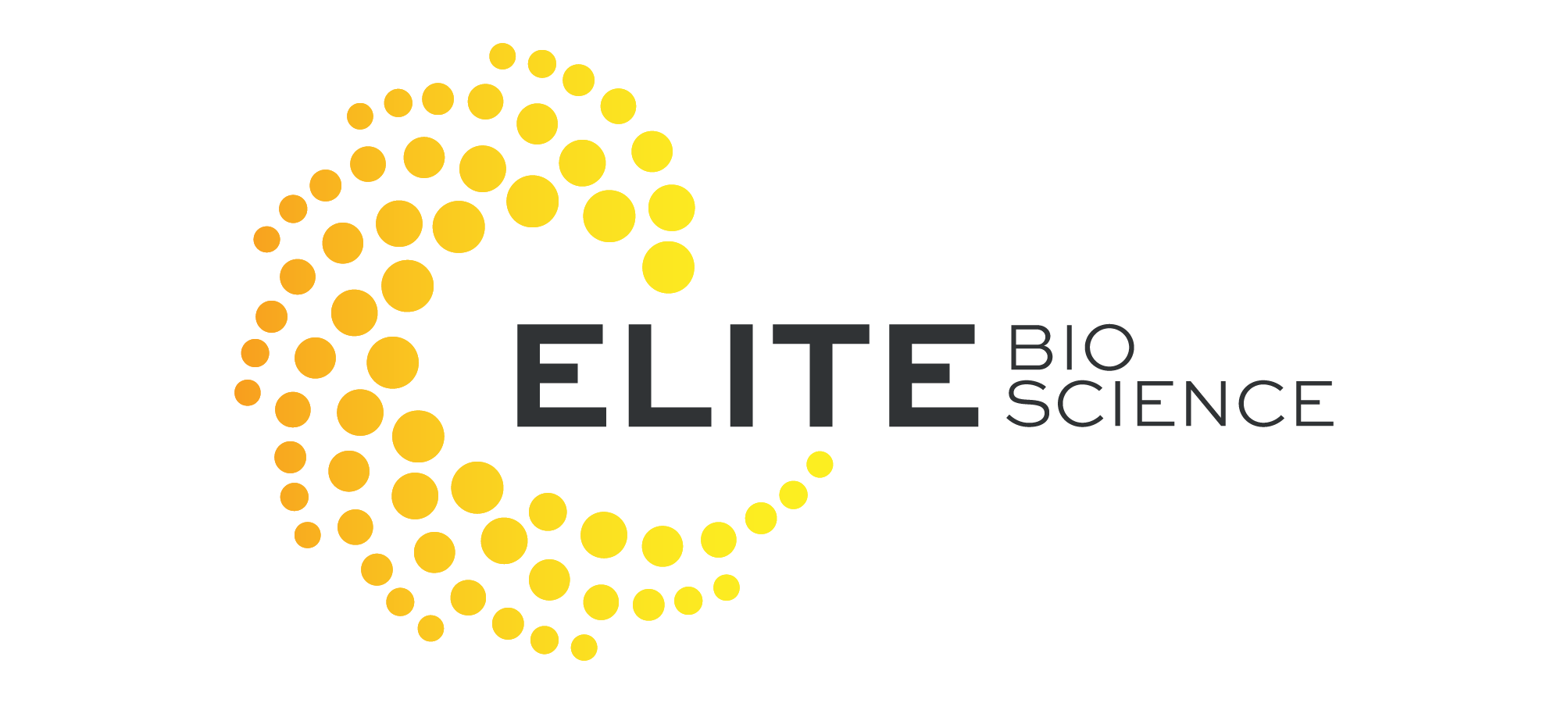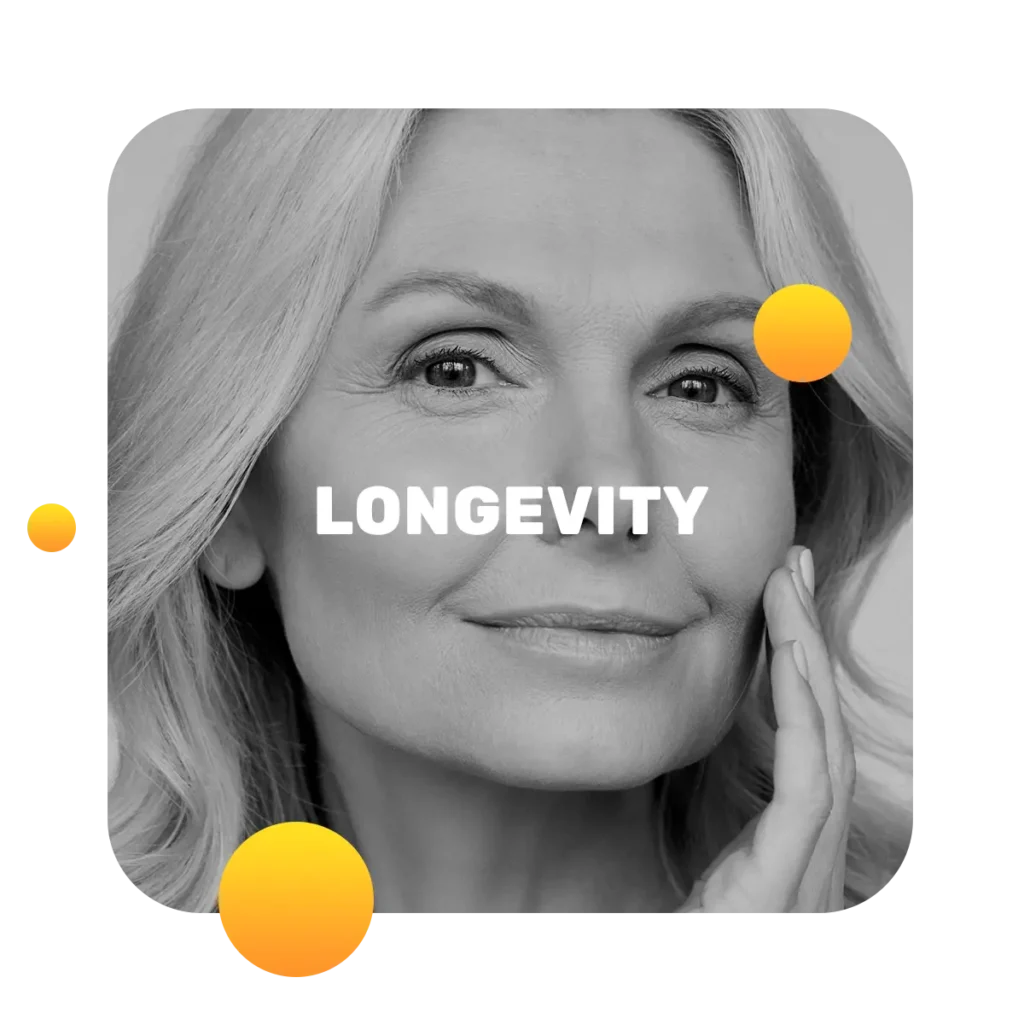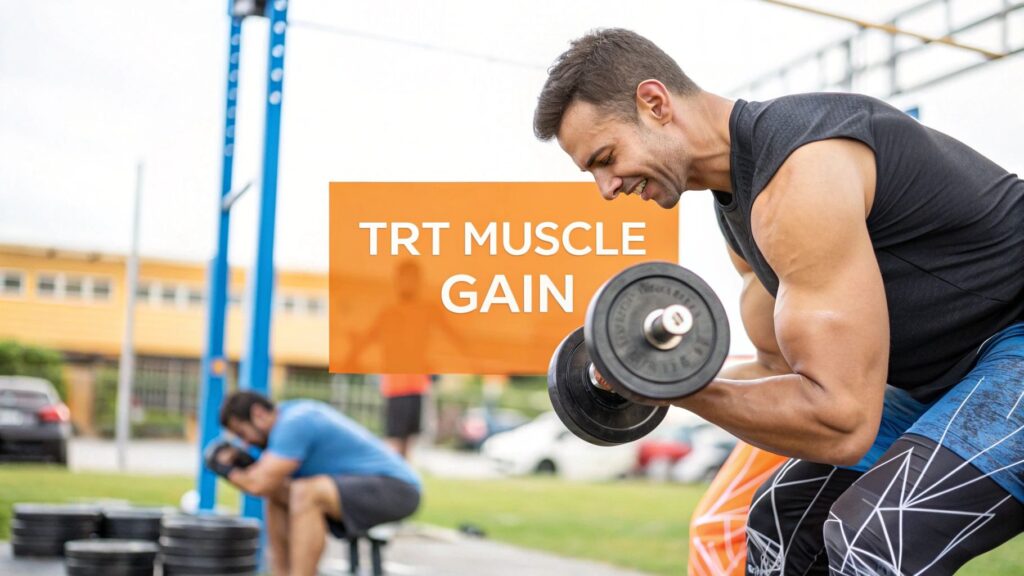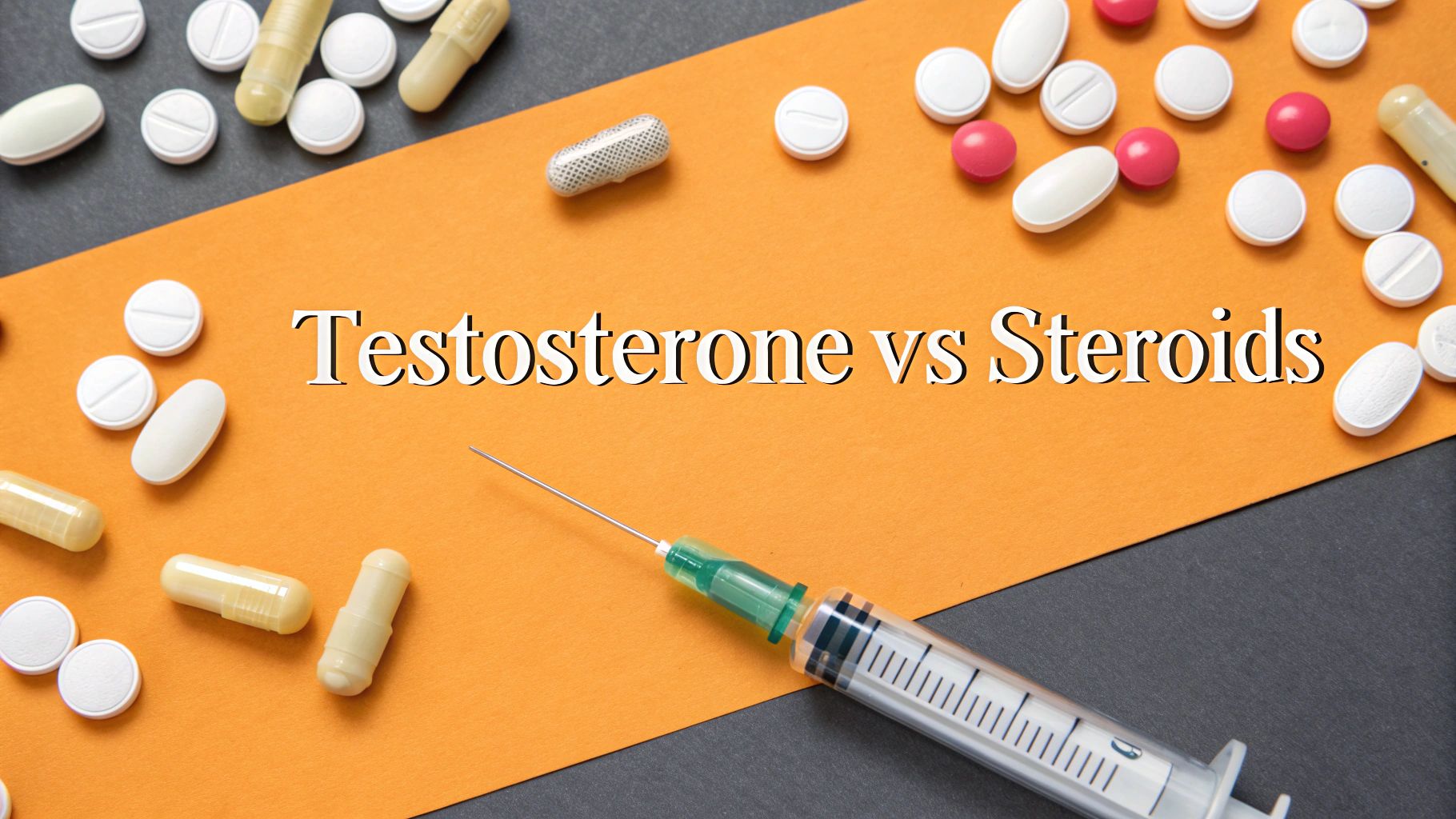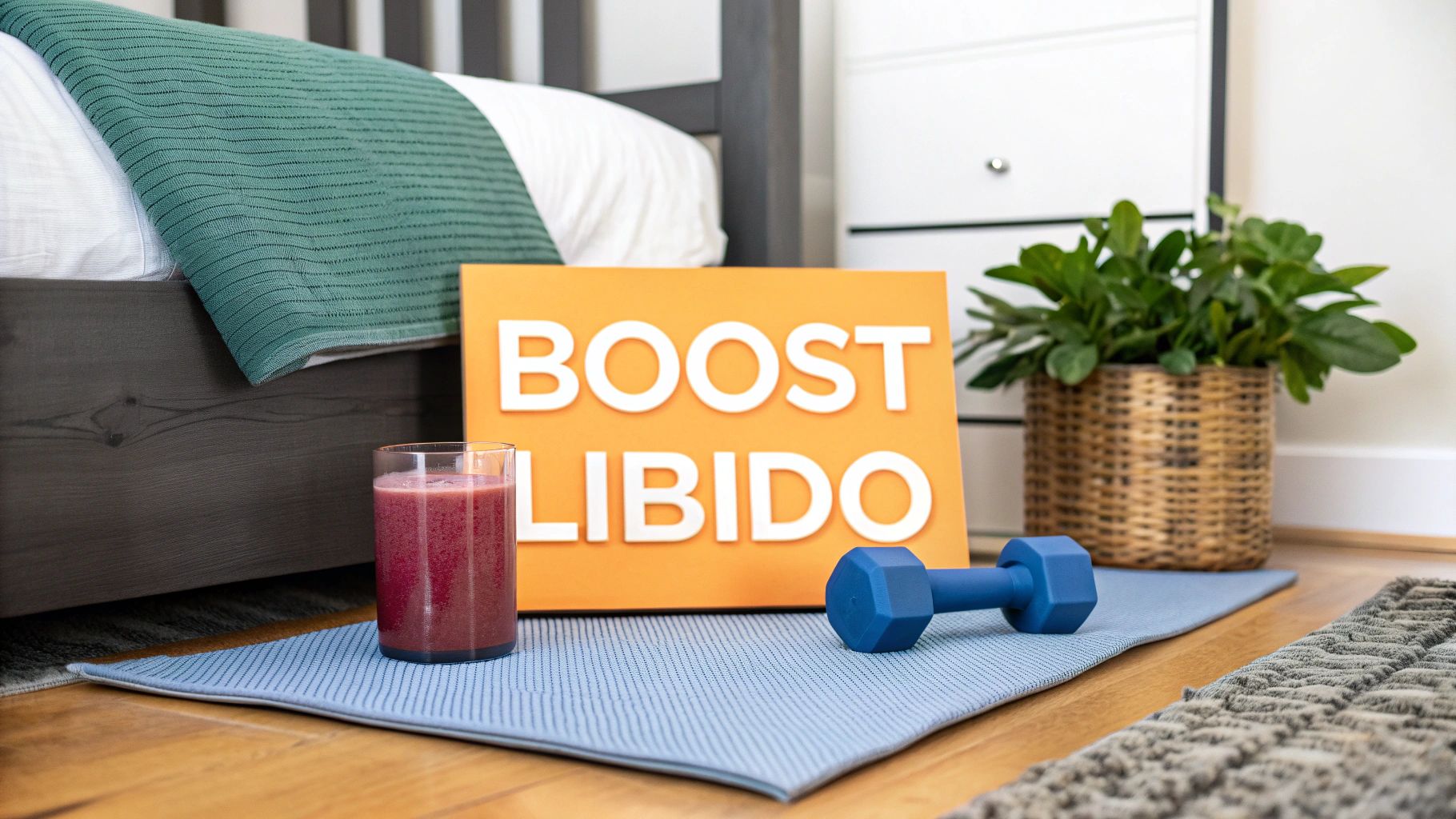Let's cut right to the chase. For a man with clinically low testosterone, TRT can be a game-changer for building muscle. It works by creating the ideal internal environment for growth, essentially restoring your body's natural blueprint for repairing and building tissue. This allows all your hard work in the gym to finally translate into real, noticeable gains.
The Real Link Between TRT and Muscle Gain
Testosterone is the primary hormone that governs muscle mass, bone density, and even how your body stores fat. As men get older, it's normal for testosterone production to dip. This decline can be sped up by lifestyle habits or certain medical issues, leading to classic symptoms like shrinking muscle mass, constant fatigue, and low energy—making it incredibly tough to build or even hang on to a strong physique.
When managed by a medical professional, testosterone replacement therapy (TRT) gets straight to the root of the problem by restoring your testosterone levels to a healthy, youthful range. This isn't about pushing your hormones into some extreme, unnatural zone. It's about rebuilding the biological foundation your body needs to operate at its best.
Restoring Your Anabolic Potential
Anabolism is simply the state where your body is building and repairing tissues, including muscle. Testosterone is a powerful anabolic hormone, and when your levels are low, your body’s ability to kick into this muscle-building gear is severely handicapped. TRT effectively flips that switch back on.
This restoration has a massive impact on how your body responds to exercise. The microscopic tears you create in your muscle fibers during a good workout are the signal for growth. With optimized testosterone levels, your body can react to that signal far more efficiently.
The key takeaway is that TRT doesn't create muscle out of thin air. Instead, it creates the ideal hormonal environment for muscle protein synthesis—the process of repairing and rebuilding muscle fibers—to occur at an accelerated rate.
What Does the Science Say?
The connection between TRT and muscle gain isn't just something guys talk about in the gym; it's backed by solid clinical evidence. Even without hitting the weights, TRT has been shown to produce small to moderate increases in lean body mass. In fact, deep dives into high-quality studies show that treatments lasting three months or more lead to an average gain of 1.5 to 3.5 kilograms of lean mass. This effect is especially powerful for men starting out with low testosterone, making it a crucial tool against age-related muscle loss. You can explore more about how testosterone promotes muscle growth for a deeper look into the research.
This all means that while your diet and training program are the essential sparks for growth, TRT makes sure your body has the hormonal fuel to actually build the fire. Without it, you could be putting in all the effort without ever seeing the full reward.
To set clear expectations, it's helpful to see how different factors influence your potential for muscle gain on TRT.
Realistic TRT Muscle Gain Potential
This table summarizes what you might expect under different circumstances, from just starting therapy to combining it with a dedicated fitness regimen.
| Scenario | Expected Muscle Gain (Approximate) | Key Factors |
|---|---|---|
| TRT Without Consistent Training | 1-2 kg over 6-12 months | Primarily restores baseline muscle mass lost due to low T. Gains are modest and primarily lean mass. |
| TRT with Beginner Training | 3-5 kg over the first year | The "newbie gains" effect is amplified by optimized hormone levels. Progress is often rapid at first. |
| TRT with Experienced Training | 2-4 kg over the first year | Helps break through plateaus. Gains are high-quality, dense muscle, but the rate is slower than a beginner's. |
| TRT with Aggressive Training & Diet | 4-7+ kg over the first year | Maximizes genetic potential by combining optimal hormonal environment with disciplined nutrition and intense training. |
As you can see, TRT provides the foundation, but your lifestyle—especially your commitment to training and nutrition—is what truly determines the final result.
The bottom line is that your training and diet provide the building blocks and the stimulus for muscle growth, but TRT acts as the master foreman, ensuring the entire construction process runs smoothly and efficiently.
How Testosterone Biologically Builds Muscle
To really get why there’s such a strong link between TRT and muscle gain, we have to go deeper than the weight room and look at what’s happening inside your body on a cellular level. Think of testosterone as the master key to your muscle-building factory. Its main job is to fit into specific locks on your muscle cells called androgen receptors. When that key turns, it sends a powerful go-ahead signal straight to the cell's command center—the nucleus.
This signal kicks off a process called muscle protein synthesis, which is the nuts and bolts of how muscle is actually built. It’s the direct biological action of repairing the tiny tears you create during training and replacing them with newer, stronger muscle tissue. If you don't have enough testosterone "keys," a lot of those receptor "locks" stay shut, and the entire muscle-building operation grinds to a halt.
The Anabolic Cascade Effect
Once those androgen receptors are unlocked, they set off a chain reaction that cranks up muscle growth. One of the biggest parts of this is an increase in another potent growth hormone, Insulin-like Growth Factor 1 (IGF-1).
Testosterone and IGF-1 are a tag team. Testosterone gets the ball rolling, but IGF-1 steps in to speed up tissue recovery and boost the activity of satellite cells.
Satellite cells are basically tiny, dormant muscle-building crews just waiting on standby. Testosterone not only wakes them up but also tells them to multiply, creating a much larger workforce ready to repair and expand your muscle fibers. This is absolutely critical for achieving long-term, sustainable muscle growth.
This biological teamwork means every single rep you fight for in the gym becomes far more productive. The workout stimulus you create is met with a powerful, hormonally charged response, which leads to faster recovery and much more significant hypertrophy (muscle growth) over time.
This infographic shows the direct pathway from declining hormones to the benefits of medically supervised TRT.
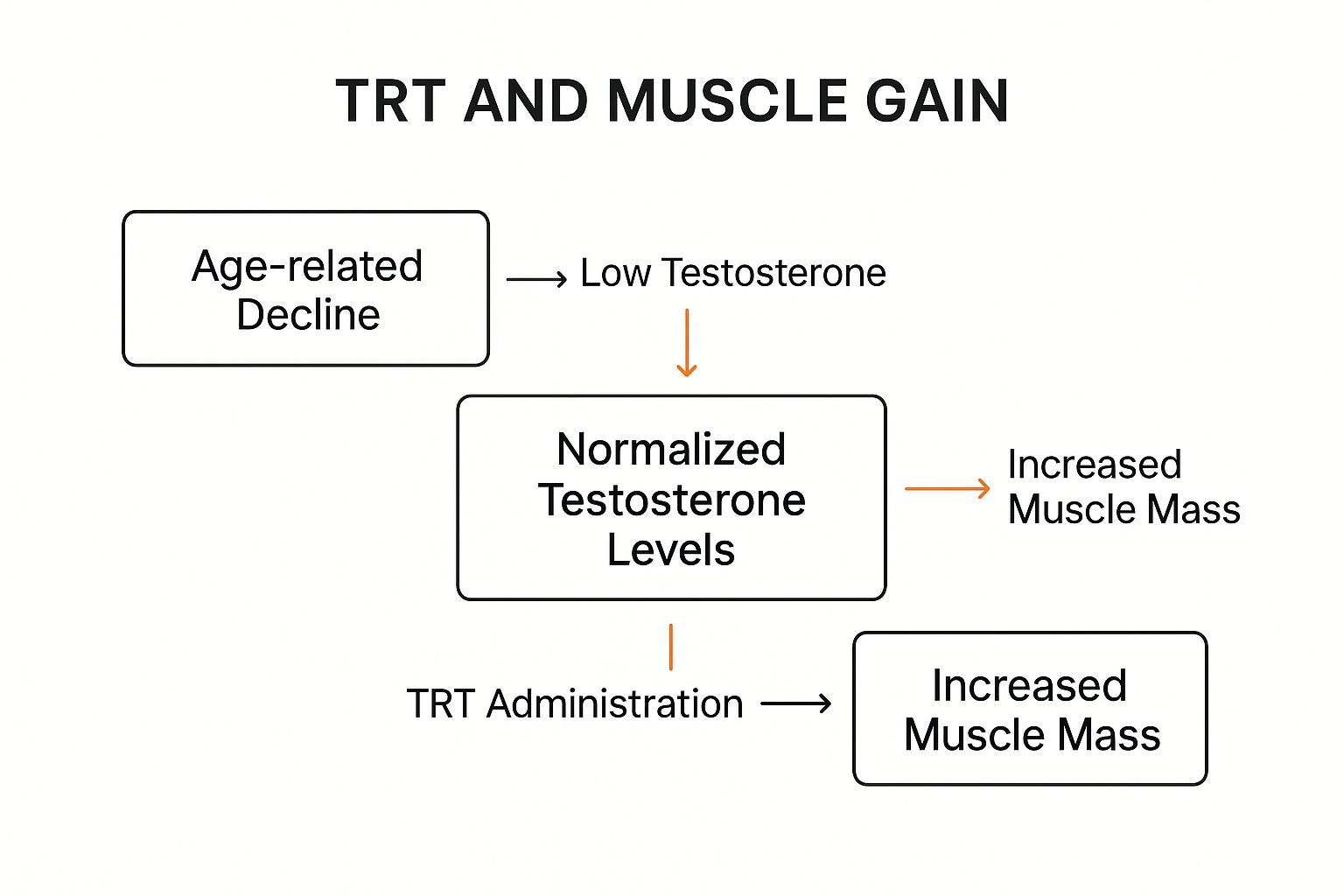
As the visual clearly shows, TRT directly addresses age-related hormone decline, creating the right internal environment to build more muscle mass.
Shielding Your Muscle From Breakdown
Building muscle is only half the job; you also have to protect the gains you've already made. This is where testosterone plays defense, specifically against cortisol—the stress hormone famous for breaking down hard-earned muscle tissue in a process called catabolism.
Testosterone and cortisol have an inverse relationship. When your testosterone levels are where they should be, it effectively blunts cortisol's muscle-wasting effects. This creates a much better anabolic-to-catabolic ratio, meaning your body spends more time in a muscle-building state and less time in a muscle-destroying one. This protective shield is a huge reason why guys on TRT find it easier to hold onto lean mass, even when stressed or cutting calories.
Enhancing Neuromuscular Efficiency
Testosterone’s influence isn't just limited to the muscle cells. It also sharpens the communication lines between your brain and your muscles, a concept known as neuromuscular efficiency. A better connection means better performance.
This enhanced signaling leads to:
- Better Muscle Recruitment: Your central nervous system gets better at calling more muscle fibers into action during a lift, which directly translates to more force.
- Increased Strength Output: With more fibers firing together, you can simply lift heavier weights, creating a more powerful stimulus for growth.
- Improved Recovery: A more efficient nervous system bounces back faster between workouts, allowing you to train harder and more often.
This neurological upgrade is a direct contributor to the strength gains that drive muscle hypertrophy. While TRT is incredibly effective, it's just one part of a bigger picture. You can also dive into our guide on the secrets to boosting testosterone levels naturally for a complete strategy. Optimizing your body’s own production can work hand-in-hand with therapy to support your overall health.
What to Realistically Expect from TRT
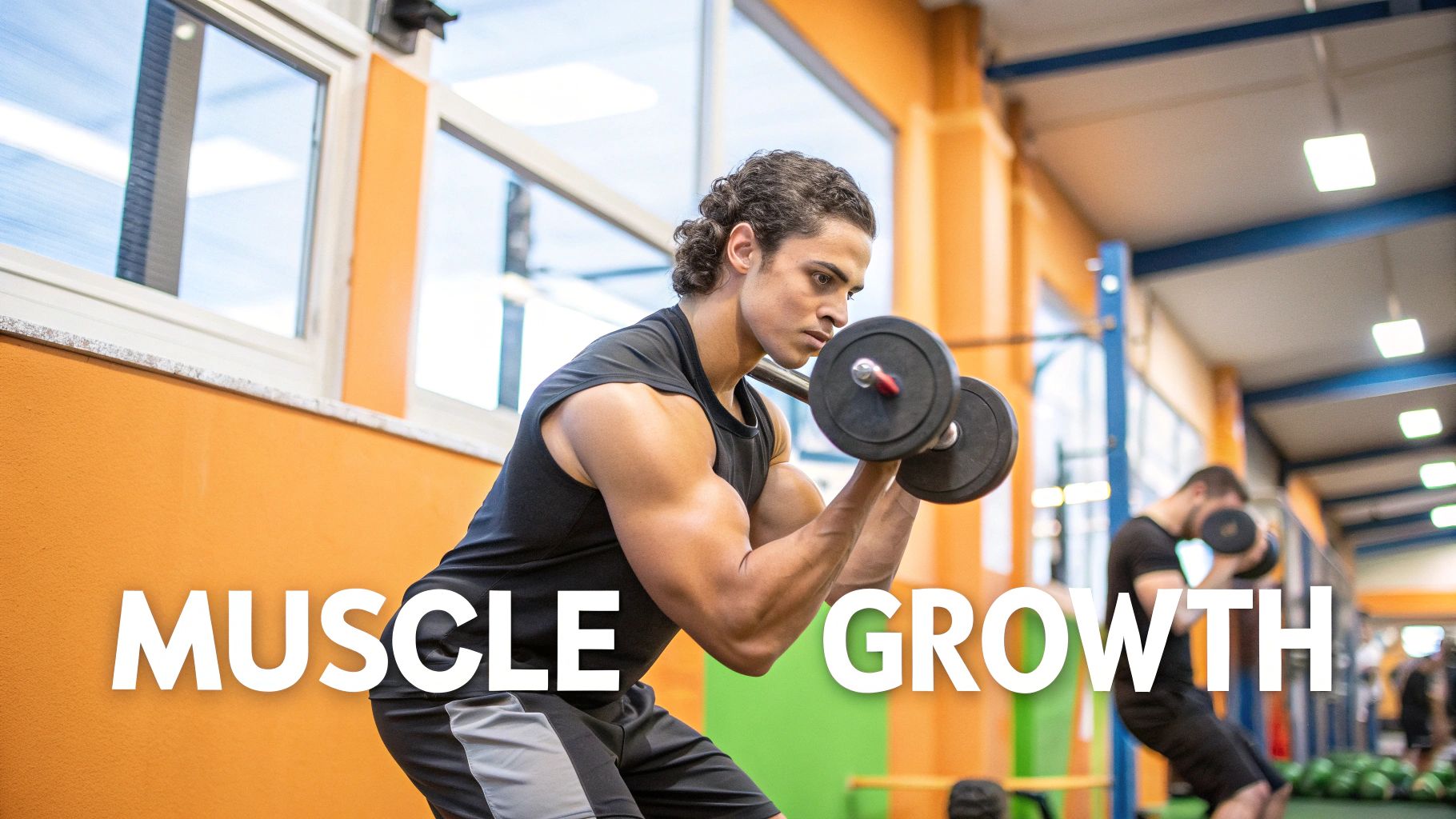
It’s easy to scroll through dramatic before-and-after photos and get swept up in gym lore, but it’s vital to ground your expectations in reality. Testosterone Replacement Therapy is a medical treatment designed to restore your body’s normal function, not a shortcut to a pro bodybuilder's physique. The goal is to bring you back to your optimal, healthy baseline.
Think of it this way: if your car's engine is only firing on half its cylinders, a mechanic doesn't "supercharge" it; they fix it so it runs the way it was designed. TRT does the same for your hormonal system. It creates the potential for growth that was previously locked away, but the actual TRT and muscle gain you see will be progressive, not explosive.
The Initial Phase What to Expect First
In the first few weeks and months, the most significant changes are often felt, not seen. Patients almost universally report a noticeable lift in energy, mood, mental clarity, and libido long before they see a big difference in the mirror.
This initial period is your body recalibrating. Your entire system is adapting to optimized hormone levels, which lays the essential groundwork for future physical changes. You might feel stronger in the gym well before you look stronger, as your neuromuscular efficiency—the connection between your brain and muscles—improves first.
Setting Realistic Muscle and Strength Goals
While TRT definitely creates an anabolic environment primed for growth, the results are steady and cumulative, not overnight. A landmark 3-year randomized controlled trial gives us a clear picture of what to expect. In the study, older men on TRT saw modest but statistically significant gains in lean body mass and muscle strength. Specifically, they improved their chest-press strength and had more power in their arms and legs. But while the benefits were real and measurable, the researchers described the magnitude as "small." You can read the full research about these testosterone findings to get a better sense of the study’s scope.
The takeaway? You will absolutely get stronger and build muscle more effectively than you could with low testosterone. It just happens over months and years, not weeks.
A healthy perspective is key. Success on TRT isn't about transforming overnight. It's about consistently feeling better, performing better, and gradually building a stronger, leaner physique that reflects your hard work.
The amount of muscle you ultimately gain is deeply personal and influenced by several factors. These variables create a unique outcome for every man, which is why comparing your journey to someone else's is a recipe for frustration.
Key Factors Influencing Your Results:
- Your Starting Point: A man with severely low testosterone (e.g., below 200 ng/dL) will likely see more dramatic changes than someone starting in the low-normal range (e.g., 350 ng/dL).
- Age and Genetics: Your DNA ultimately sets the ceiling for your muscle-building potential, and your age influences how quickly you get there.
- Commitment to Training and Diet: TRT provides the key, but your lifestyle turns it. Consistent resistance training and a protein-rich diet are non-negotiable for unlocking your full potential.
- Adherence to Protocol: Following your doctor's prescribed protocol without fail is crucial. Stable hormone levels are the foundation for steady, reliable progress.
By understanding these variables, you can set achievable goals and appreciate the progress you make. The real magic happens at the intersection of medical therapy and a dedicated lifestyle—that’s where the most impressive and sustainable results are found.
Combining TRT with Effective Resistance Training
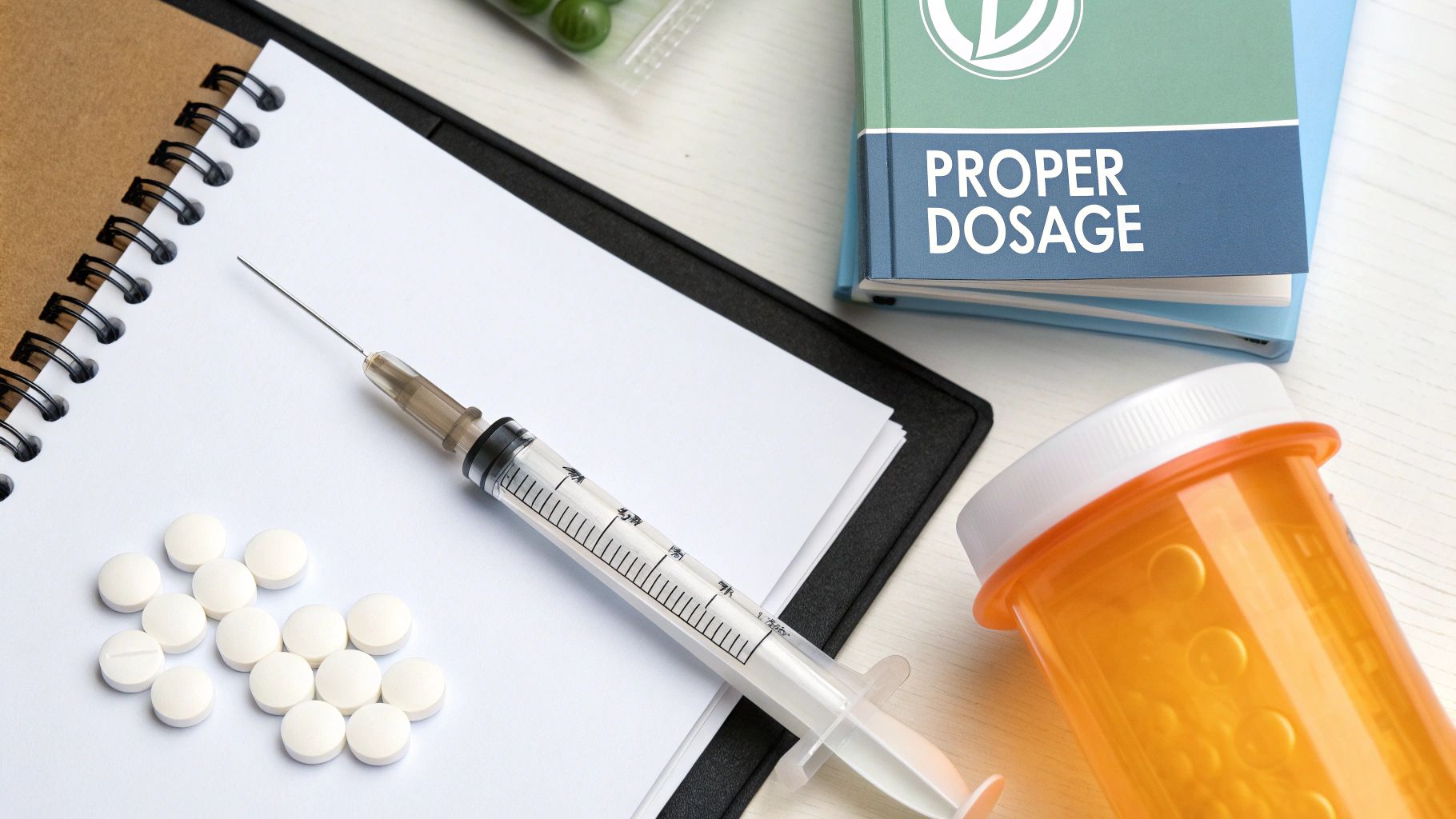
While TRT creates the perfect internal state for growth, this is where the rubber truly meets the road. Think of it this way: your body is a high-performance engine that has just been expertly tuned with TRT. Resistance training is the act of stepping on the gas pedal. Without it, the engine just idles; with it, you finally unleash its full power.
The combination of TRT and muscle gain isn't just additive; it’s multiplicative. The synergy between optimized testosterone and a smart workout plan creates a powerful feedback loop. Training provides the stimulus—those microscopic tears in muscle fibers—and TRT supercharges the repair process, leading to superior gains in size and strength. You simply get more bang for your buck from every single workout.
This isn't just a theory; it's a well-documented phenomenon. A controlled study found that men who combined testosterone injections with resistance exercise saw the biggest increases in both lean muscle mass (around 5.7%) and strength (10-13%) compared to every other group. What's truly remarkable is that the men on testosterone who didn't train still gained more muscle than the group that trained without testosterone. That really underscores the hormone's profound anabolic power. You can read more about these groundbreaking TRT findings for a detailed look at the study.
Building Your Training Blueprint
To really capitalize on the anabolic environment TRT provides, your training needs to be smart, intense, and consistent. The goal isn't just to lift weights but to send the strongest possible growth signal to your muscles.
The absolute cornerstone of any effective muscle-building program is a laser focus on compound movements. These are the multi-joint exercises that recruit huge amounts of muscle mass all at once.
Compound lifts are your biggest allies. They not only build the most muscle in the least amount of time but also trigger a more significant natural hormonal response, further amplifying the effects of your TRT.
The Most Impactful Compound Exercises
Prioritizing these movements will give you the best return on your investment in the gym. They are the foundation upon which a strong, muscular physique is built.
- Squats: Often called the king of all exercises, squats work your entire lower body—quads, hamstrings, glutes—and heavily engage your core for stability. They are second to none for building raw leg strength and mass.
- Deadlifts: This is the ultimate full-body movement, stimulating nearly every muscle from your traps down to your calves. Deadlifts are phenomenal for building a thick, powerful back and posterior chain.
- Bench Press: The primary exercise for developing the chest, shoulders, and triceps. Mastering the bench press is key for building upper-body pushing strength and size.
- Overhead Press: Without a doubt, this is the best movement for building powerful, broad shoulders. It also demands serious core strength and stability, making it a functional and effective upper-body builder.
- Bent-Over Rows: The perfect counterpart to the bench press, rows build thickness and width in your upper back, lats, and biceps. A strong back is essential for good posture and overall strength.
Structuring Your Workouts for Maximum Growth
While the exercises you choose are important, how you structure them is just as critical. The principle of progressive overload must be your guiding star. It's a simple concept: you must continually challenge your muscles by gradually increasing the weight, reps, or sets over time.
A solid weekly split might look something like this:
- Day 1: Upper Body (Focus on Bench Press & Rows)
- Day 2: Lower Body (Focus on Squats & Leg Press)
- Day 3: Rest or Active Recovery
- Day 4: Upper Body (Focus on Overhead Press & Pull-ups)
- Day 5: Lower Body (Focus on Deadlifts & Lunges)
- Day 6 & 7: Rest
This kind of structure ensures each muscle group gets hit twice a week with enough time to recover. Remember, muscle growth happens during recovery, not during the workout itself. While TRT will dramatically improve your ability to recover, you still need to listen to your body and prioritize rest to prevent overtraining and maximize the TRT and muscle gain connection.
Fueling Your Body for Maximum Muscle Growth
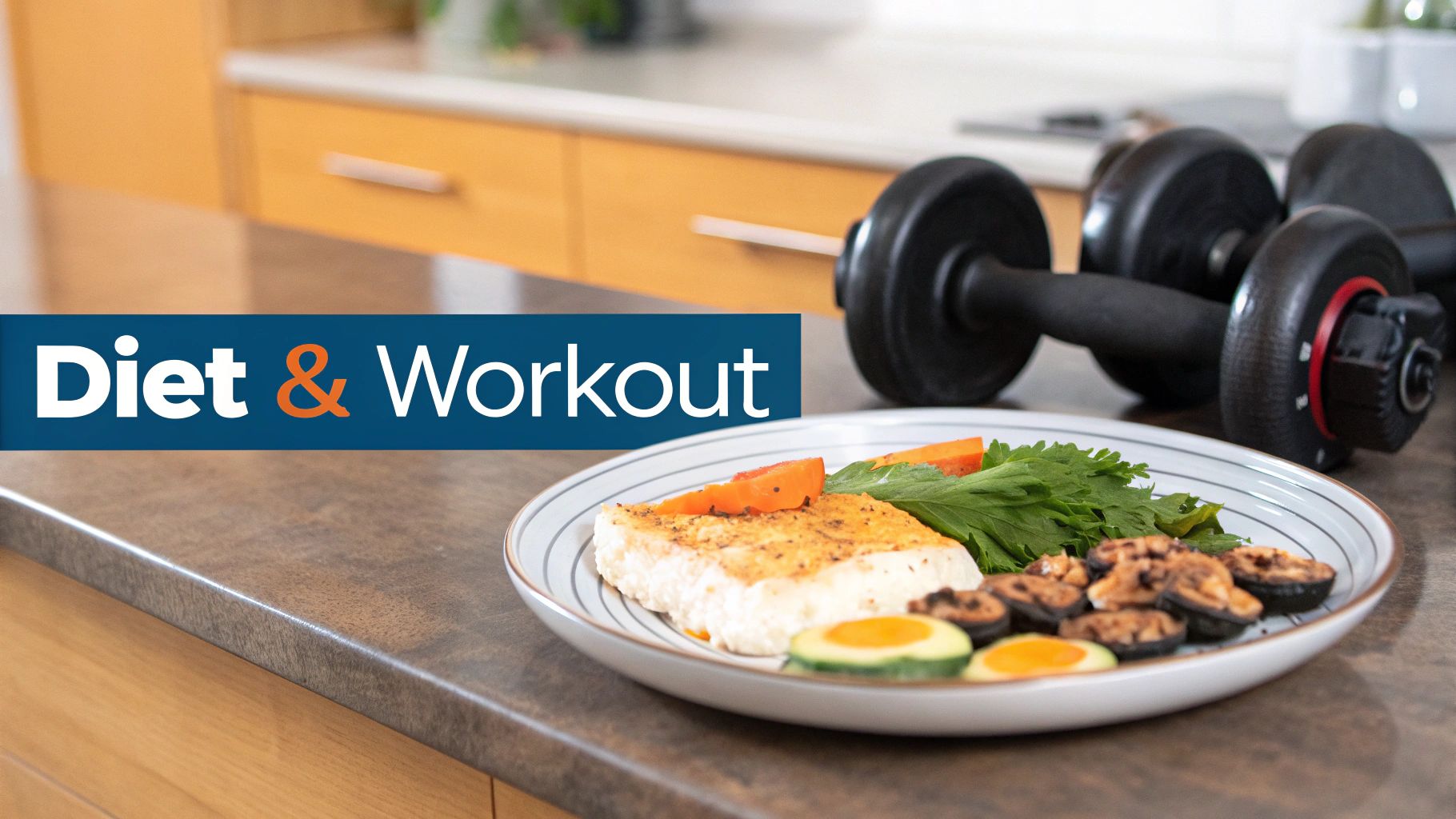
While TRT and resistance training lay the foundation, your diet provides the actual raw materials for growth. Think of it this way: TRT is the expert construction foreman and your workouts are the work order, but your nutrition—the protein, carbs, and fats—is the steel, concrete, and power needed to raise the skyscraper.
Without the right fuel, your body simply can't build new muscle tissue, no matter how optimized your hormones or intense your training sessions are. A disciplined diet amplifies the anabolic signals from both TRT and your workouts, ensuring the TRT and muscle gain connection is firing on all cylinders. This is your guide to eating and living in a way that truly maximizes your results.
Mastering Your Macronutrients For Muscle
To build muscle effectively, you have to give your body the right building blocks in the right amounts. It all comes down to mastering your three primary macronutrients: protein, fats, and carbohydrates.
Prioritize Protein: Your Muscle-Building Blocks
Protein is, without a doubt, the single most important nutrient for muscle repair and growth. After you break down muscle fibers in the gym, it's the amino acids from protein that your body uses to rebuild them bigger and stronger. Since TRT is already enhancing your body's muscle protein synthesis, giving it a steady supply of protein is non-negotiable.
For optimal muscle gain, research consistently points to a protein intake of around 1.6 to 2.2 grams per kilogram of body weight (or roughly 0.7 to 1.0 gram per pound).
A 200-pound (90kg) man, for instance, should aim for approximately 140-200 grams of protein daily. This isn't just a suggestion; it's a biological necessity to support the heightened anabolic state created by TRT.
Focus on high-quality, lean protein sources to hit this target:
- Lean Meats: Chicken breast, turkey, and lean cuts of beef.
- Fish: Salmon, tuna, and cod are excellent sources of protein and healthy omega-3 fatty acids.
- Eggs & Dairy: Whole eggs, Greek yogurt, and cottage cheese are protein powerhouses.
- Plant-Based Options: Lentils, chickpeas, and tofu can also contribute significantly.
Strategize Carbs and Fats for Fuel and Hormones
While protein builds the muscle, carbohydrates and fats provide the energy and hormonal support to make it all happen. Carbs are your body’s go-to energy source, fueling you through demanding workouts. Timing them around your training can give you the power to push harder and lift heavier.
Healthy fats are just as important, playing a critical role in hormone production and overall health. Including sources like avocados, nuts, seeds, and olive oil helps ensure all your body's systems are running smoothly—which is absolutely vital when you're on hormone therapy.
Lifestyle Habits That Amplify Results
What you do outside the gym and kitchen is just as critical for your progress. Sleep and stress management are two of the most powerful, yet frequently overlooked, factors in any fitness journey.
The Anabolic Power of Sleep
You don't build muscle in the gym; you build it while you rest. During deep sleep, your body releases human growth hormone (HGH), a key player in tissue repair and recovery. TRT helps with recovery, but skimping on sleep completely short-circuits this natural process, undermining all your hard work.
Aim for 7-9 hours of quality sleep per night. This gives your body the time it needs to fully repair damaged muscle fibers and solidify the gains you've earned. For those looking to optimize every aspect of their growth, you might find value in our guide on the best supplements for muscle growth in 2025, which explores options that can complement a solid nutrition and recovery plan.
Control Cortisol to Protect Your Gains
Chronic stress is the enemy of muscle growth. High stress levels lead to elevated cortisol, a catabolic hormone that actively breaks down muscle tissue and encourages fat storage. It works directly against the anabolic environment you’re trying so hard to create with TRT and training.
Find effective ways to manage your stress, such as:
- Meditation or mindfulness practices
- Light cardio like walking
- Spending time in nature
- Engaging in hobbies you truly enjoy
By weaving these nutritional and lifestyle strategies into your routine, you create a complete system where every element—therapy, training, diet, and recovery—works together to produce the best possible results.
Navigating Your TRT Protocol Safely
Getting your TRT protocol right is a non-negotiable part of the journey. This isn’t just about maximizing the TRT and muscle gain connection; it’s about safeguarding your long-term health. The single most critical step you can take is to work with a knowledgeable physician. They’re your guide, ensuring your treatment is both effective and responsible.
Think of your TRT protocol as a precision instrument, not a sledgehammer. The goal is to restore your testosterone levels to an optimal, healthy range—not to blast them to extreme, risky heights. This health-first approach is what separates legitimate medical therapy from the reckless world of anabolic steroid abuse.
Administration and Dosage
The delivery method you choose for your testosterone plays a huge role in your protocol. Your doctor will walk you through the options, helping you select the best fit based on your lifestyle, personal preferences, and how your body responds.
Common TRT Administration Methods:
- Injections: Typically given weekly or bi-weekly, injections are highly effective at keeping your hormone levels stable and consistent.
- Topical Gels: You apply these daily to the skin, making them a convenient, non-invasive choice. The main drawback is you have to be careful not to transfer the medication to anyone else.
- Nasal Sprays: A newer option that provides fast absorption through the nasal lining, though it usually requires more frequent dosing.
Once you’ve settled on a method, your physician will carefully figure out your starting dose. This is never a one-size-fits-all number. It’s a calculated decision based on your initial bloodwork, your age, and the symptoms you’re experiencing.
The Importance of Consistent Monitoring
Your journey doesn't end once you start treatment. In fact, that’s just the beginning. Regular blood tests are absolutely essential to make sure your protocol is working correctly and, most importantly, safely. This is about way more than just checking your total testosterone level.
Monitoring is your safety net. It allows your doctor to make precise, small adjustments to your dosage, heading off potential side effects long before they become serious problems. This proactive management is the key to a successful and sustainable TRT experience.
Your physician will keep a close eye on several key markers, including:
- Estradiol: As your testosterone increases, some of it naturally converts to estrogen. Keeping estradiol in a healthy balance is crucial for your mood, libido, and avoiding side effects like water retention.
- Hematocrit: TRT can sometimes ramp up red blood cell production. Monitoring hematocrit ensures your blood doesn't become too thick, which could increase the risk of clotting.
By understanding why monitoring is important for testosterone replacement therapy, you become an active partner in your own health. This collaborative relationship with your doctor is what ensures your path to muscle gain is built on a solid foundation of safety and well-being.
Common Questions About TRT and Muscle Gain
When you’re thinking about starting TRT, especially with the goal of building a stronger physique, a lot of questions pop up. Getting straight, no-nonsense answers is the key to setting the right expectations and making good decisions for your health and fitness journey.
This section cuts through the noise to address the most common things men wonder about when it comes to TRT and muscle gain. Let's tackle the questions that come up time and time again.
How Quickly Will I See Muscle Gains?
This is easily the number one question, and the honest answer is: it takes patience. You'll likely feel stronger and more energetic within just a few weeks of starting TRT, but visible changes in muscle mass take a bit longer to show up. Your body needs time for its internal hormonal environment to level out and create the right conditions for new growth.
For most guys, it takes about 3 to 6 months of consistent therapy—paired with a solid resistance training program and a smart diet—to see significant, measurable gains in muscle size. The "feel good" effects definitely come first, but the physical transformation is a steadier, more gradual process.
It's crucial to understand the difference between feeling stronger and looking visibly more muscular. The initial neurological boost in strength often comes much sooner than the slower, metabolic process of hypertrophy (actual muscle growth). Consistency is your best friend here.
Can I Stop TRT After Gaining Muscle?
This is a very common misconception. TRT isn't a temporary muscle-building cycle; it’s a long-term medical treatment for men with a clinical diagnosis of hypogonadism. The whole point is to restore your testosterone to healthy levels and keep it there.
If you stop your prescribed therapy, your body will simply go back to its old, low baseline. As a result, you’ll gradually lose the muscle and strength you worked so hard to build. The benefits of TRT, including that enhanced potential for muscle gain, only last as long as you continue the treatment under a doctor's supervision.
Is TRT the Same as Taking Steroids?
No, and this is an incredibly important distinction. The two are worlds apart in both their purpose and how they are used.
Testosterone Replacement Therapy (TRT): This is a medical treatment that uses physiological doses prescribed and monitored by a doctor. The goal is to bring your hormone levels back into a normal, healthy range to fix the symptoms of low testosterone. It's about restoring health.
Anabolic Steroid Abuse: This involves using supraphysiological (unnaturally high) doses of testosterone or other synthetic hormones without any medical supervision. The goal is extreme performance enhancement, which comes with severe and often permanent health risks.
Think of it this way: TRT is a legitimate medical therapy focused on health and well-being. Illicit steroid use is a dangerous gamble that prioritizes extreme results over your safety.
Ready to explore how a medically supervised TRT program can safely help you reach your health and fitness goals? At Elite Bioscience, we provide expert guidance and tailored therapies to optimize your well-being. Visit us today to learn more and begin your journey.
